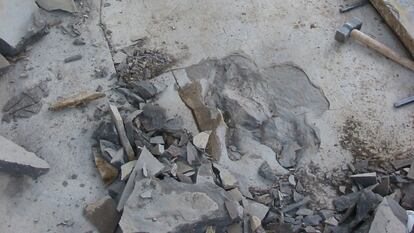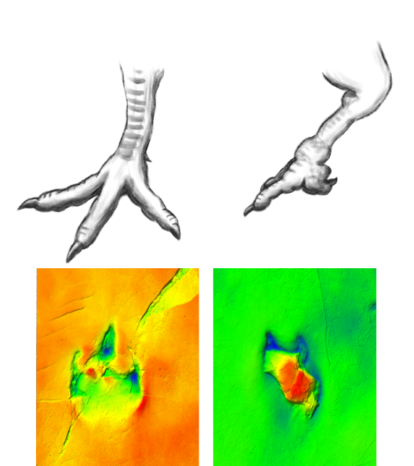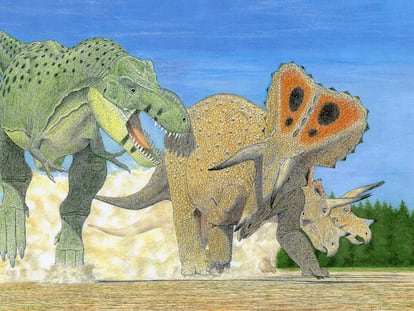The limping dinosaur who roamed Spain 129 million years ago
A series of six tracks found in the east-central Cuenca region were found to belong to a single individual with a pathology on its left leg

A group of researchers has analyzed a trail of six dinosaur footprints at the archeological site of Las Hoyas in Cuenca, east-central Spain, and that dates back 129 million years. These impressions correspond to a dinosaur from the theropod group that had not been identified until now. What’s special about these tracks is that, while those of the right foot are completely normal with the three characteristic toes, those of the left foot were deformed and one of the toes was dislocated.
What’s more, the tracks are spaced out when compared to other trails found from the subgroup, at around 1.10 meters, according to the authors of a study on the find. This could suggest that the individual adjusted their walk due to the injured foot. This is backed up by certain deformations in the right tracks, which suggest that the animal was putting more weight on that side. The dinosaur stepped over other trails left by fish. The results of this study were published on Wednesday on Plos One, a website for the publication of scientific articles.
The footprints on the trackway are 45 centimeters apart, prompting the scientists to calculate that the animal’s hip height would have been 190 centimeters, and it would have had a body length of six to seven meters. “It’s one of the biggest animals that we have discovered or that we interpret to have had the biggest size of everything that has been discovered in Las Hoyas,” explains Ángela D. Buscalioni, a paleontologist and director of the Center for Integration in Paleobiology (CIPb-UAM), and one of the authors of the study. The researcher explains that much was already known about the diversity of animals that lived in this wetland via their fossils, but that in this case, they have been able to discover more about the site due to the animals that passed through there on a seasonal basis.
Despite the first tracks being discovered more than a decade ago, the trail has particularities that have taken “considerable time and work to interpret and determine what happened to the dinosaur when it crossed that wetland,” she explains. They have not ruled out finding more footprints on the same track. The conclusions of the study have found that the dinosaur left a trail when it crossed an area of shallow water while it was walking toward the main source of water.

Analysis also showed that the trail was left on a microbial carpet. According to Buscalioni, this is formed by algae and bacteria and covered the surface or bottom of a waterlogged area, which is “exactly what was in the lower part of these pools at the site.”
“The sediment in Las Hoyas is very particular because in some way it is generated by the growth of microbial carpets,” she explains. This, they assume, is very important for the preservation of so many animals and fossils at the site.
This study was carried out by a group of multidisciplinary researchers. To develop it, they used a 3D scanner that provides very specific details of the surface of the tracks. It was accompanied by metric studies, as well as sedimentology analysis. The trail was also compared with samples of another 75 trackways of bipedal dinosaurs.
A number of different discoveries have been made at this site, since analysis began there around 30 years ago. It is even the protagonist of a book, Las Hoyas: A Cretaceous Wetland, written by Buscalioni and Francisco José Poyato Ariza, in which the first work carried out at the site, directed by José Luis Sanz, is summarized.
In the book, Las Hoyas is described as a laboratory of natural history, where new questions are always arising. Sanz is part of the team of three Spanish scientists who published research in 2010 in Nature magazine, in which they discovered and gave a name to a new species of dinosaur: Concavenator corcovatus. Two decades before, they had already found Pelecanimimus polyodon at the same site. It was the first ornithomimosaur to be described in Europe, according to a study recently published in the Zoological Journal of the Linnean Society.
Francisco Ortega, a paleontologist who has participated in some of these discoveries and is a professor at Spain’s UNED distance-learning university, points to the fact that this place is a very relevant site given its exceptional conservation, which provides very precise details about what was happening on the Iberian peninsula 130 million years ago. “It has very specific fossilization conditions,” he explains. “That makes the site very special and allows us to identify different things from what we generally see at others.”
Tu suscripción se está usando en otro dispositivo
¿Quieres añadir otro usuario a tu suscripción?
Si continúas leyendo en este dispositivo, no se podrá leer en el otro.
FlechaTu suscripción se está usando en otro dispositivo y solo puedes acceder a EL PAÍS desde un dispositivo a la vez.
Si quieres compartir tu cuenta, cambia tu suscripción a la modalidad Premium, así podrás añadir otro usuario. Cada uno accederá con su propia cuenta de email, lo que os permitirá personalizar vuestra experiencia en EL PAÍS.
¿Tienes una suscripción de empresa? Accede aquí para contratar más cuentas.
En el caso de no saber quién está usando tu cuenta, te recomendamos cambiar tu contraseña aquí.
Si decides continuar compartiendo tu cuenta, este mensaje se mostrará en tu dispositivo y en el de la otra persona que está usando tu cuenta de forma indefinida, afectando a tu experiencia de lectura. Puedes consultar aquí los términos y condiciones de la suscripción digital.
More information
Últimas noticias
Pinochet’s victims grapple with José Antonio Kast’s rise in Chile
Reinhard Genzel, Nobel laureate in physics: ‘One-minute videos will never give you the truth’
How Japan is trying to avert ‘digital defeat’
The complicated life of Francesca Albanese: A rising figure in Italy but barred from every bank by Trump’s sanctions
Most viewed
- Pablo Escobar’s hippos: A serious environmental problem, 40 years on
- Why we lost the habit of sleeping in two segments and how that changed our sense of time
- Charles Dubouloz, mountaineering star, retires at 36 with a farewell tour inspired by Walter Bonatti
- Trump’s obsession with putting his name on everything is unprecedented in the United States
- The Florida Keys tourist paradise is besieged by immigration agents: ‘We’ve never seen anything like this’











































